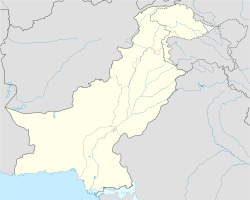HN 페가수스
HN Pegasi| 관측 데이터 Epoch J2000.0 이쿼녹스 J2000.0 | |
|---|---|
| 별자리 | 페가수스 |
| 우측 상승 | 21h 44m 31.32919s[1] |
| 탈위임 | +14° 46′ 18.9806″[1] |
| 겉보기 크기 (V) | 5.92 - 5.95[2] |
| 특성. | |
| 스펙트럼형 | G0 V CH-0.5[3] |
| U-B색지수 | +0.031[4] |
| B-V색지수 | +0.588[4] |
| 변수형 | BY Dra[5] |
| 아스트로메트리 | |
| 방사 속도 (Rv) | -16.68±0.09km[6]/s |
| 고유 운동 (μ) | RA: +190.93mas[1]/yr Dec.: -1965.46mas[1]/yr |
| 시차 (π) | 55.91 ± 0.45[1] 마스 |
| 거리 | 58.3 ± 0.5 ly (17.9 ± 0.1 pc) |
| 절대치수 (MV) | 4.70[7] |
| 세부 사항 | |
| HN Peg A | |
| 미사 | 1.085±0.091[5] M☉ |
| 반지름 | 1.002±0.018[5] R☉ |
| 루미도(골수계) | 1.090[7] L☉ |
| 표면 중력 (log g) | 4.45[8] cgs |
| 온도 | 5,961[8] K |
| 금속성 [Fe/H] | -0.06[8] 덱스 |
| 회전 | 4.84 d[9] |
| 회전 속도 (v sin i) | 12.81km[10]/s |
| 나이 | 237±33[5] 마이어 |
| HN 페그 B | |
| 반지름 | 0.101[11] R☉ |
| 표면 중력 (log g) | 4.81[11] cgs |
| 온도 | 1115K[11] |
| 기타 지정 | |
| 데이터베이스 참조 | |
| 심바드 | HN Peg A |
| HN 페그 B | |
HN 페가수스자리(HN Pegasi)는 북부 페가수스 별자리에 있는 태양과 같은 젊은 별을 나타내는 변수별 명칭이다.그것은 겉으로 보이는 시각적 크기가 5.9로, [4]보틀 척도에 따르면 교외 하늘에서 육안으로 볼 수 있다는 것을 나타낸다.히파르코스 우주선에 의한 시차 측정은 이 별을 약 58광년 거리에 놓았다.[1]
이것은 G0 V CH-0.5의[3] 별 분류와 2억 3천 7백만 년으로 추정되는 G형 주계열성이다.태양보다 질량이 약간 더 많고 반지름은 약간 크지만 야금성은 다소 낮다.[5][8]추정 회전기간은 4.84일로[9] 비교적 빠르게 돌고 있다.
그 별의 표면 자기장은 복잡하고 가변적인 기하학을 가지고 있다.BY 드라코니스 변광성(BY Draconis variable star)으로, 활성 크롬스피어가 있어 항성점(star spot)에 의한 광도(luminity)의 회전변조가 있음을 의미한다.태양과 마찬가지로, 별점 활동은 약 5.5±0.3년 동안 지속되는 최대값과 최소값의 주기 주기를 거친다.[5]겉보기 크기는 24.9일 동안 최대 5.92에서 최소 5.95 사이에서 변화한다.[2]그러나 회전 기간은 평균 4.84일이다.별은 새로운 사이클이 시작될 때 초기 값으로 다시 떨어지기 전에 각 사이클 동안 회전율이 꾸준히 증가하는 항솔라 회전 패턴을 보여준다.[9]
2007년에는 갈색 왜성의 동료의 발견이 발표되었다.HN 페그 B는 스피처 우주망원경을 43.2 아크초의 각진격차로 사용한 것이 포착돼 T형 난쟁이들의 메탄 방출 특성을 보여줬다.이 분리는 795 AU의 예상 물리적 거리에 해당하며,[13] 이러한 갈색 왜성 동료들에게는 드물게 넓다.물체의 추정 질량은 28M이다J. 그 스펙트럼에 근거하여 HN Peg B는 상대적으로 얇은 구름 데크를 가지고 있다.[11]
이 별은 적외선 과다 방출로 궤도에 이물질의 원반이 존재함을 암시한다.[7]HN Pegasi는 아마도 얇은 디스크 모집단의 별일 것이다.[8]우주를 통해 공통된 움직임을 공유하는 것은 근처의 헤라클레스-리라 항성 협회의 일원이다.[5]
참조
- ^ a b c d e f van Leeuwen, F. (2007), "Validation of the new Hipparcos reduction", Astronomy and Astrophysics, 474 (2): 653–664, arXiv:0708.1752, Bibcode:2007A&A...474..653V, doi:10.1051/0004-6361:20078357, S2CID 18759600.
- ^ a b Samus, N. N.; Durlevich, O. V.; et al. (2009), "VizieR Online Data Catalog: General Catalogue of Variable Stars (Samus+ 2007-2013)", VizieR On-line Data Catalog: B/GCVS. Originally Published in: 2009yCat....102025S, 1: B/gcvs, Bibcode:2009yCat....102025S.
- ^ a b Gray, R. O.; et al. (July 2006), "Contributions to the Nearby Stars (NStars) Project: spectroscopy of stars earlier than M0 within 40 pc-The Southern Sample", The Astronomical Journal, 132 (1): 161–170, arXiv:astro-ph/0603770, Bibcode:2006AJ....132..161G, doi:10.1086/504637, S2CID 119476992.
- ^ a b c Blanco, C.; et al. (1979), "Photoelectric observations of stars with variable H and K emission components. III", Astronomy and Astrophysics Supplement Series, 36: 297–306, Bibcode:1979A&AS...36..297B.
- ^ a b c d e f g Boro Saikia, S.; et al. (January 2015), "Variable magnetic field geometry of the young sun HN Pegasi (HD 206860)", Astronomy & Astrophysics, 573: 16, arXiv:1410.8307, Bibcode:2015A&A...573A..17B, doi:10.1051/0004-6361/201424096, S2CID 53316047, A17.
- ^ Nidever, David L.; et al. (August 2002), "Radial Velocities for 889 Late-Type Stars", The Astrophysical Journal Supplement Series, 141 (2): 503–522, arXiv:astro-ph/0112477, Bibcode:2002ApJS..141..503N, doi:10.1086/340570, S2CID 51814894.
- ^ a b c Ertel, S.; et al. (May 2012), "A peculiar class of debris disks from Herschel/DUNES. A steep fall off in the far infrared", Astronomy & Astrophysics, 541: 14, arXiv:1203.6784, Bibcode:2012A&A...541A.148E, doi:10.1051/0004-6361/201118077, S2CID 5457432, A148.
- ^ a b c d e Ramírez, I.; et al. (February 2013), "Oxygen abundances in nearby FGK stars and the galactic chemical evolution of the local disk and halo", The Astrophysical Journal, 764 (1): 78, arXiv:1301.1582, Bibcode:2013ApJ...764...78R, doi:10.1088/0004-637X/764/1/78, S2CID 118751608.
- ^ a b c Messina, S.; Guinan, E. F. (October 2003), "Magnetic activity of six young solar analogues II. Surface Differential Rotation from long-term photometry", Astronomy and Astrophysics, 409 (3): 1017–1030, Bibcode:2003A&A...409.1017M, doi:10.1051/0004-6361:20031161.
- ^ Martínez-Arnáiz, R.; et al. (September 2010), "Chromospheric activity and rotation of FGK stars in the solar vicinity. An estimation of the radial velocity jitter", Astronomy and Astrophysics, 520: A79, arXiv:1002.4391, Bibcode:2010A&A...520A..79M, doi:10.1051/0004-6361/200913725, S2CID 43455849.
- ^ a b c d Leggett, S. K.; et al. (August 2008), "HN Peg B: A Test of Models of the L to T Dwarf Transition", The Astrophysical Journal, 682 (2): 1256–1263, arXiv:0804.1386, Bibcode:2008ApJ...682.1256L, doi:10.1086/589146, S2CID 15701830.
- ^ "V* HN Peg -- Variable of BY Dra type", SIMBAD Astronomical Database, Centre de Données astronomiques de Strasbourg, retrieved 2015-12-07.
- ^ Luhman, K. L.; et al. (January 2007), "Discovery of Two T Dwarf Companions with the Spitzer Space Telescope", The Astrophysical Journal, 654 (1): 570–579, arXiv:astro-ph/0609464, Bibcode:2007ApJ...654..570L, doi:10.1086/509073, S2CID 11576708.



